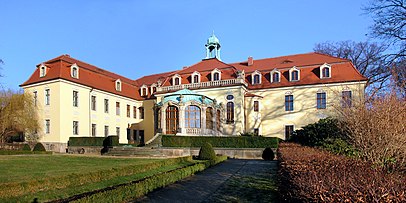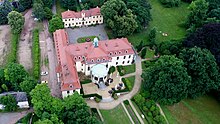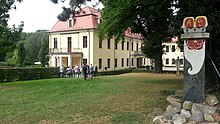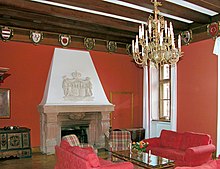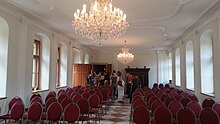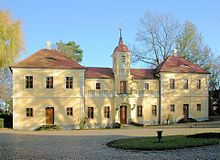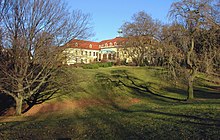Proschwitz Castle
Proschwitz Castle is a New Baroque style castle in the Meißner district of Proschwitz in the district of Meißen . Affiliated with it is Saxony's oldest still existing private winery in Zadel .
history
The Proschwitz vineyards were owned by the Meißner bishops from the middle of the 12th century until the Reformation . A large part of the mass wines required in Saxony came from the Proschwitz winery during this time.
A knight Eckbert von Proschwitz was first mentioned in a document from 1102. The place name Proschwitz indicates an early Sorbian settlement. Until the Reformation and the subsequent secularization of most ecclesiastical goods, Proschwitz was an episcopal table good of the Meissen Monastery .
From 1554 the property was owned by Ernst von Miltitz. This also included the Nassau Vorwerk . After the castle was destroyed in the Thirty Years' War , Peter Werdemann acquired the property in 1657 together with the patronage rights for Zscheila . The start of construction on the baroque palace can be traced back to the von Schilling family , who acquired the property in 1704. In 1732 it was bought by the widowed Countess Magdalena von Beichlingen, née von Miltitz, and built a simple L-shaped baroque palace. After the Countess's death, the property passed into the possession of her second daughter, the Countess von Gersdorff. In 1790 the Saxon court marshal and baron Carl Friedrich von Berlepsch acquired the castle. It then passed to the von Carlowitz family by inheritance .
In the period from 1882 to 1888, Proschwitz Castle was expanded to the west by adding a residential wing. In 1901 the wedding of Imperial Count Clemens zur Lippe-Biesterfeld-Weißenfeld with Friederike Freiin von Carlowitz took place at the castle . From 1914 onwards, the castle was restored by Clemens Reichsgraf zur Lippe-Biesterfeld-Weißenfeld under the leadership of the architects Lossow & Kühne . After the death of Princess Friederike zur Lippe-Weißenfeld in 1943, the palace was confiscated by the NSDAP. Later children from bomb-prone regions of Germany were housed in the castle .
Shortly after the end of the Second World War , Christian Prinz zur Lippe , the son of Clemens and Friederike, was expropriated without compensation as part of the land reform , imprisoned with his family and finally expelled to the western occupation zones. The castle was looted and later used as a pulmonary hospital. In 1979 it was converted into a district rehabilitation center for mentally handicapped children and adults. Since 1990 Georg Prinz zur Lippe (* 1957) has been buying back his parents' vineyards bit by bit and rebuilding the Proschwitz Castle winery in Zadel . In 1996, Prinz zur Lippe also bought back his parents' castle, which could be used to care for the disabled until September 2000. After the repurchase, the castle had to be renovated piece by piece over the years due to extensive structural damage. Georg Prinz zur Lippe was significantly supported by the German Foundation for Monument Protection . Concerts, park and castle festivals, banquets, conferences and weddings are held today at Proschwitz Castle and Park.
Servant house
The servants' house on the east side of the castle courtyard was built in 1776, whereby the core of the building is of older structure. It consists of two two-storey, baroque hipped roof pavilions, connected by an intermediate building with a blind balustrade on the upper floor and a clock tower with a hood.
Castle Park
At the beginning of the 19th century, an English landscape garden with a size of five hectares was created in the west and south of the heavily moved terrain of the Knorrgrund . From 1913, the geometric-French gardens in the style of the early 18th century were laid out in front of the west facade. A larger than life sandstone figure of an armored warrior from the 17th century, probably a gift from Fontainebleau , adorns the park , which houses an old medieval wine cellar .
winery
The Schloss Proschwitz winery in Zadel is the oldest private winery in Saxony. Viticulture beyond the 50th parallel is made possible by the southern disposition of the vineyards, the favorable microclimate of the Elbe valley and the combination of loess loam and granite rock.
Between 1990 and 2008 the winery was renovated. The company is based in a four-sided courtyard from the 18th century. In 1996 the winery was included in the Association of German Predicate and Quality Wineries (VDP). The location Schloss Proschwitz belongs to Großlage Spaargebirge within the range Meissen in the wine region of Saxony .
The area under vines is 98.6 hectares in 2015 (100%). In 2015, 92.4 hectares (93.7%) were in yield.
The share of the grape varieties is divided
| Grape variety | Area in ha | Area share in% |
|---|---|---|
| Gray burgundy | 16.1 | 16.4 |
| Müller-Thurgau | 15.0 | 15.3 |
| White Burgundy | 12.2 | 12.4 |
| Elbling | 8.6 | 8.7 |
| Riesling | 8.3 | 8.4 |
| Scheurebe | 8.2 | 8.3 |
| Pinot Noir | 6.6 | 6.7 |
| Gold Riesling | 6.4 | 6.5 |
| Dornfelder | 6.3 | 6.4 |
| Pinot Noir | 4.5 | 4.6 |
| Traminer | 3.4 | 3.5 |
| regent | 2.2 | 2.2 |
| Black Riesling | 0.5 | 0.5 |
| Dark fields | 0.2 | 0.2 |
| Pinotin | 0.1 | 0.1 |
Young plants occupy approx. 6.2 hectares, which corresponds to 6.3% of the vineyard area.
Prinz zur Lippe also manages 46 hectares of vineyards in Schöndorf (Weimar) , which were opened up in 2008. However, a purchase of the Liebstedt Ordensburg planned for these locations and its restoration as a winery failed, as did the planned purchase of Kromsdorf Castle .
literature
- Klaus Fröhlich, Hinrich Jürgen Petersen: Proschwitz: the village-the castle-the wine: 800 years of changes, transformations. Norderstedt 2011, ISBN 978-3-8423-8030-1 .
- Cornelius Gurlitt: Descriptive representation of the older architectural and art monuments in Saxony. Booklet 41: Administrative Authority Meißen-Land. Dresden 1923, pp. 403-405.
- Till Ehrlich : In the river of the tides. The prince, the wine and the Meissen granite. The story of a return. In: FINE - Das Weinmagazin, No. 5/2009, ISBN 3-937963-96-0 .
- Margarete Hamer-Princess of Lippe-Weißenfeld: 275 years of Lippe-Weißenfeld. Volume 1: Hike from the Lippe region to Lusatia. Based on family history sources. Sollermann, Leer / Ostfriesland 2009, ISBN 978-3-938897-30-0 .
- Margarete Hamer-Princess of Lippe-Weißenfeld: 275 years of Lippe-Weißenfeld. Volume 2: Hike from Lipper Land via Niederlausitz to Oberlausitz. Based on family historical sources. Oberlausitzer Verlag Nürnberger, Spitzkunnersdorf 2017, ISBN 978-3-936867-68-8 .
- Pit Falkenstein: Prince and Farmer . In: weekend Journal No. 59, supplement to the Handelsblatt from March 23, 2007.
- Work for the rise east . In: Handelsblatt of October 6, 2006.
- My Freedom - Stories from Germany , pp. 26–34: Georg Prinz zur Lippe: His friends declare him crazy , Kathrin Höhne / Maren Martell, publisher: epubli GmbH, Berlin 2014, ISBN 978-3-7375-0615-1
Web links
- Website of the winery
- In 1790 Baron von Berlepsch acquired the castle
- Castle history
- Proschwitz on sachsen-bilder.de
- Proschwitz Castle Winery. Meeting in Gault-Millau .
- Entry in the Wein-Plus wine guide
Individual evidence
- ↑ Klaus Fröhlich, Hinrich Jürgen Petersen: Proschwitz: the village-the castle-the wine: 800 years of changes, metamorphoses. Norderstedt 2011, p. 46 f.
- ↑ Thüringische Landeszeitung from November 5, 2014
Coordinates: 51 ° 10 ′ 45.2 ″ N , 13 ° 28 ′ 31.1 ″ E
